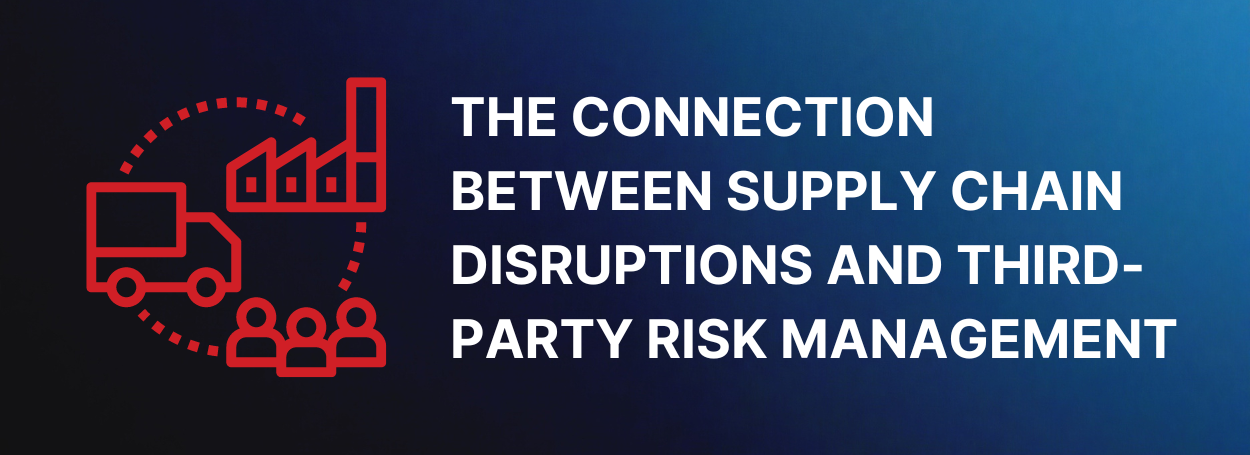The Connection Between Supply Chain Disruptions and Third-party Risk Management

Supply chain disruptions have become common in the post-COVID world. From personal care items like toilet paper, tampons, and hand sanitizer, to medical supplies, auto parts, and food products – the pandemic led to shortages of all these goods and more.
If all of this weren’t enough, another shortage crisis reared its head in 2022 – that of baby formula in the United States. The crisis started to gather steam in February 2022 when Abbott Nutrition, the country’s biggest infant formula maker, recalled several brands of baby formula. The U.S. FDA also shut down the company’s facilities in Michigan after discovering unsanitary conditions and contaminated products on the premises.
All these developments sent shockwaves through the country. It also exacerbated socioeconomic inequities in the nation and left millions of vulnerable groups – among them children – without access to life-sustaining food and nutrition.
By the start of May, 40% of baby formula was out of stock. The problem was worse in large, densely-populated cities like Atlanta and Sacramento, where out-of-stock rates exceeded 90%.
Ongoing supply chain issues due to COVID, America’s strict import regulations, and the fact that 98% of the formula consumed domestically is produced in the country all made a bad situation worse. Further, legislation that allows a few companies to dominate the market contributed further to the disaster.
The U.S. baby formula shortage crisis underscores the need for supply chain resilience. It also demonstrates the importance of third-party risk management (TPRM) for companies in every industry.
Causes and Sources of Supply Chain Disruptions
A June 2021 statement by the White House mentioned how supply chain disruptions during the pandemic caused the dramatic shrinkage of several industries in the U.S. These disruptions held back business activity, led to acute goods shortages, and resulted in abrupt price increases.
The authors also said that the situation was particularly difficult for businesses with “complex supply chains, as their production is vulnerable to disruption due to shortages of inputs from other businesses.”
According to Accenture, 94% of Fortune 1000 companies experienced supply chain disruptions from COVID-19. The pandemic also had a strong negative impact on 75% of firms. These figures – and the baby formula shortage crisis – show that in the post-COVID era, supply chain disruptions are no longer a question of “if” but “when”.
Disruptions are now omnipresent and unpredictable, and also constant and impactful. And because modern supply chains in all industries cross national borders, a disruption originating in one country is keenly felt by companies and their customers in many other countries.
In recent years, the global Coronavirus pandemic has been the biggest cause of supply chain disruptions. Other causes of upheaval include supplier threats, natural disasters, political uncertainties, and socioeconomic upheavals like war. Cyber and terrorist attacks, as well as rapid shifts in market dynamics and consumer preferences can also disrupt supply chains.
The next section explores the causes of supply chain disruptions that led to baby formula shortages.
The Baby Formula Shortage Crisis: Precipitating Factors and the Need for Third Party Risk Management
Between February and July 2022, supply chain issues drove the stocks of baby formula frighteningly low and raised prices to alarming highs. The crisis shows how supply chain disruptions can cause chaos in the marketplace and why TPRM is a critical aspect of supply chain risk management.
The formula shortage crisis resulted from multiple disruptive forces coming together at the same time. For one, U.S. legislations and policies allowed industry concentration by a few large players, like Abbot Laboratories, which holds 40% of the market share. Consequently, the shutdown of its manufacturing facility directly impacted formula supplies in the market.
The federal Women, Infants, and Children (WIC) program also contributed to the crisis. The WIC funds over half of the baby formula purchased across the country. Although it is an effective anti-hunger program, it does have a weakness: a “sole-source” contracting process. The process enables some state providers to monopolize the formula market for that state which then prevents other players from adding to the formula supply needed by consumers.
The country’s over-dependence on locally-produced formula is another supply chain challenge. Formula products from Europe are banned in the U.S. because they don’t meet the FDA’s standards for product labeling. High import tariffs and the high cost of transporting their products also discourage non-U.S. producers from supplying formula to the U.S. market.
Finally, since baby formula has a stable demand, its profitability potential is low, so producers have little incentive to invest in “just-in-case” capacity. Consequently, there is a lot of competition to reduce prices which also increases the risk of supply disruptions.
The formula crisis has revealed major flaws in the U.S. food supply chain. It shows how problems at any stage of the supply chain make the entire market vulnerable to supply and price shocks and how no organization is exempt from these problems. However, companies can reduce the impact of such shocks on their own operations. Here’s where TPRM comes in. TPRM aims to identify risks that may be created by third parties in an organization’s supply chain and mitigate their damaging impact.
How TRPM Can Minimize the Impact of Supply Chain Disruptions
In 2020, Deloitte found that 85% of organizations had not developed the capability to manage their third-party risks. These firms underperformed in many areas of supply chain management. They also had inadequate monitoring processes relative to third-party risks.
Such underinvestment in TPRM programs left organizations vulnerable to supply chain disruptions in the face of the Coronavirus pandemic. The same weaknesses became visible during the baby formula crisis as well.
Modern supply chains consist of a complex web of many parties, such as:
- Vendors
- Suppliers
- Outsourcing partners
- Contractors
- Service providers
Most businesses depend on some or all of these organizations to run their operations and achieve their strategic goals. However, third parties also introduce many risks into the business landscape such as:
- Financial risk
- Legal risk
- Compliance risk
- Transactional risk
- Operational risk
- Strategic risk
- Cybersecurity risk
The realization of any of these risks could impact a company’s revenues, damage its reputation, and result in regulatory fines or legal action. On a broader level, third-party risks disrupt supply chains, leading to shortages similar to the ones seen due to COVID and the baby formula crisis.
Organizations need TPRM to effectively manage and mitigate these risks. Companies that invest in TPRM are better able to weather supply chain upheavals.
TPRM also:
- Provides greater visibility into the end-to-end supply chain
- Reveals current and emerging threats and risks in third-party processes
- Provides actionable insights to help companies act early and mitigate the impact of disruptions
- Improves reporting and decision-making with respect to third-party relationship management and accountability-building
4 Strategies to Prepare for Supply Chain Disruptions and Boost Supply Chain Resilience
The pandemic has disrupted supply chains since early 2020. These shocks worsened in 2021 due to the blockages in the Suez Canal and tanker ship logjams. And then in 2022, there were serious shortages of baby formula shortage due to product recalls, plant shutdowns, and other economic/political causes.
All of these crises highlight the need for resilient supply chains. Organizations can make their supply chains more resilient by focusing on four crucial areas:
Identify alternate sources
Industry concentration, with only four companies controlling 90% of formula production, is one of the major causes of the shortage crisis. It shows why it’s important not to depend on a small number of companies, whether they are manufacturers, suppliers, or distributors.
Companies can boost supply chain resilience and reduce risk by developing a diverse base of suppliers and manufacturing facilities. Ideally, these entities should be in multiple regions to spread the risk of non-availability or non-performance on the supply chain.
It’s also crucial to regularly cooperate and communicate with all suppliers, manufacturers, logistics service provides, packaging suppliers, and other trading partners. By doing this, organizations can build stronger relationships with key providers and minimize supply shocks.
Increase visibility into the end-to-end supply chain
Organizations must prioritize visibility into the entire supply chain. Companies that have such end-to-end visibility are better prepared for supply chain disruptions and its resultant effects. These organizations can track the provenance of each product unit and batch.
They can predict upcoming supply or demand changes and place orders for critical ingredients or materials before a crisis breaks out. They can also limit the impact of product recalls even if they do become necessary.
Set up and integrate business processes
Companies that can track leading indicators and sense changes in supply and demand can rapidly respond to supply chain risks and opportunities. But this requires integrated business planning.
An integrated business planning solution synchronizes sales and operations planning (S&OP), inventory planning, demand-driven replenishment, and response and supply. Synchronization helps coordinate supply chain planning processes and ensures business continuity even during times of disruption.
Companies must also ensure that they have processes in place for:
- Supply chain cost management
- Supply chain sustainability
- Supply chain logistics
- Supply chain risk management (TPRM)
In addition, they must look for opportunities to get more value from their existing processes. For example, manufacturers should aim to run plants at 100% capacity, restart idle machinery, reduce machine downtime, and explore ways to streamline their product offerings. Companies should also invest more in distribution systems and technologies, so they can anticipate and respond more quickly to shortages and other supply chain shocks.
Embrace digitization to create “digital supply chains”
The COVID-19 pandemic and the formula crisis both illustrate that many companies are under-prepared to withstand global supply chains shocks. Fortunately, they can overcome this shortcoming with the help of new digital technologies.
Digital supply networks (DSNs) are replacing the traditional “linear” supply chain model to provide visibility across the supply chain (see above). By leveraging advanced technologies such as the Internet of Things (IoT), artificial intelligence (AI), and robotics, DSNs remove functional silos and eliminate knowledge gaps. They enable organizations to collaborate better with their supply network, thus optimizing the supply chain and empowering all players to better deal with unexpected circumstances.
The end goal of all the above strategies is to build more agile and resilient supply chains so organizations can respond appropriately and proactively to risks. A resilient supply chain can recover from supply chain disruptions faster, thus minimizing risk impact and the potential for losses or damage.
Supply Chain Resilience: The Role of Governments and Regulatory Agencies
The government plays a key role in minimizing supply chain disruptions and maximizing supply chain resilience. Again, the baby formula crisis reveals several lessons in this area. For example, it shows that governments should try to minimize the excessive concentration of crucial inputs in a few firms or locations.
A federal supply chain disruptions task force can help monitor and address short-term supply issues. In the long term, countries should strengthen their national industrial base to increase resilience and reduce lead times to crisis response. It’s also crucial to rebuild sustainable manufacturing capacity and address international supply chain vulnerabilities as early as possible.
Governments must explore collective approaches to supply chain resilience with international partners. They must also encourage the imports of foreign products by reducing tariffs and incentivizing new market entrants.
Effective TPRM Starts with Vendor360
Both COVID-19 and the infant formula crisis show that supply chain disruptions can happen at any time. Organizations need to prepare for such crises and build more resilient supply chains to better withstand supply chain shocks. A robust TPRM program is a good way to do both. And such programs start with the right technology and tools.
Vendor360 from CENTRL is an advanced TPRM platform. It provides actionable risk intelligence and real-time vulnerability insights that enables organizations to enhance third-party risk oversight.
With its unified risk management capabilities, companies can automate vendor risk assessments and manage inherent risk for each vendor. They can also conduct detailed vendor due diligence and assess appropriate vendor controls to increase supply chain resilience.
Schedule a demo to learn how Vendor360 can help you improve TPRM efficiency and strengthen your supply chain.


